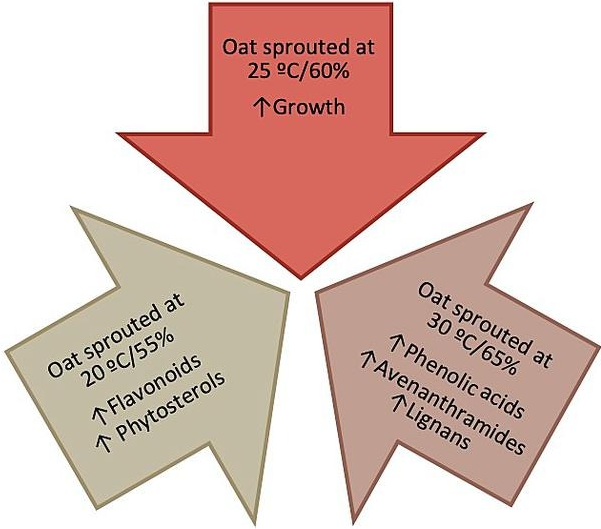Two 2023 Avena sativa oat sprout studies, starting with one that found different effects during germination from varying temperature and relative humidity:
“This study evaluated effects of temperature (20, 25, and 30°C) and relative humidity (RH, 55, 60, and 65%) as abiotic stressors during oat germination. We identified eighty polyphenols, nine avenanthramides, twelve lignans, and five phytosterols.
- 100% germination was achieved at 25°C/60% RH from day 3, yielding the longest radicle size.
- The highest content of most phenolic acids, avenanthramides, and lignans occurred at 30°C/65% RH, where 100% germination was attained by day 5, but with a shorter radicle size.
- The best flavonoid and phytosterol profile was obtained at 20°C/55% RH, achieving only a 67% germination rate by day 5.

By considering germination conditions, end-users can harness the versatility of oat sprouting to meet their specific needs and maximize potential benefits of this promising cereal crop. For instance, manufacturers of functional foods and beverages could consider using sprouts from conditions that yield high polyphenol content for products targeting antioxidant benefits, whereas nutraceutical manufacturers could focus on sprouting conditions that result in elevated levels of avenanthramides, well-known for their health-promoting properties.”
https://www.sciencedirect.com/science/article/abs/pii/S0308814623027917 “Impact of temperature and humidity conditions as abiotic stressors on the phytochemical fingerprint of oat (Avena sativa L.) sprouts” (not freely available) Thanks to Dr. Iza F. Pérez-Ramírez for providing a copy.
Another study compared and contrasted eight sprouted grains to their ungerminated grains and to each other. I’ll highlight oat sprout results:
“The method used was germination for up to 72 h at temperatures ranging from 19–23°C. Oat germination rate was 80%.
Linoleic acid (omega-6) was the predominant fatty acid in oat grain powder, followed by similar amounts of oleic and palmitic acids and smaller amounts of stearic and linolenic (omega-3) acids. Since omega-6 content remained unchanged and omega-3 quantity increased slightly in sprouted oats, the omega-6/omega-3 ratio decreased.”
https://www.mdpi.com/2304-8158/12/17/3306 “Effect of Germination on Fatty Acid Composition in Cereal Grains”
My kitchen cupboard’s oat sprouting conditions are closer to this second study’s temperature, where relative humidity wasn’t specified. I doubt that kitchen winter-time relative humidity ever rises to the 55% lower threshold of the first study for more than a few minutes.
At this time of year in Sprouting hulled oats, I got a 97% germination rate over three days with an estimated 21°C (70°F) and a relative humidity closer to 30% than 55%. Couldn’t tell you why the first study’s germination rate with 20°C/55% RH was only 67% at day 5, or why the second study’s germination rate was only 80% at day 3 with 19–23°C.
